Introduction: Aerogel is the least dense solid substance in the world, with a density of only 2.75 times that of air. The most common aerogel is silicon aerogel, which was first made by American scientist Kistler in 1931 due to a bet with a friend. Aerogel is generally prepared by sol-gel method, a nano-scale porous solid material formed by replacing the liquid phase in the gel with gas by a certain drying method. Aerogels are highly porous solids that retain the properties of individual nanomaterials on a macroscopic scale.
On February 15, 2022, researchers at the University of Hamburg developed a3D printingNanoparticle aerogel process. The process is based on direct ink writing (DIW) 3D printing technology, using titanium dioxide (TiO2) nanoparticle aerogels for printing. Can be used to manufacture solar steam power generation or thermochemical heat storage devices.
The researchers say that titanium dioxide is currently used as the basis for their research, but their technique can also be extended to other materials, and nanoparticle inks can be engineered with specific functions.
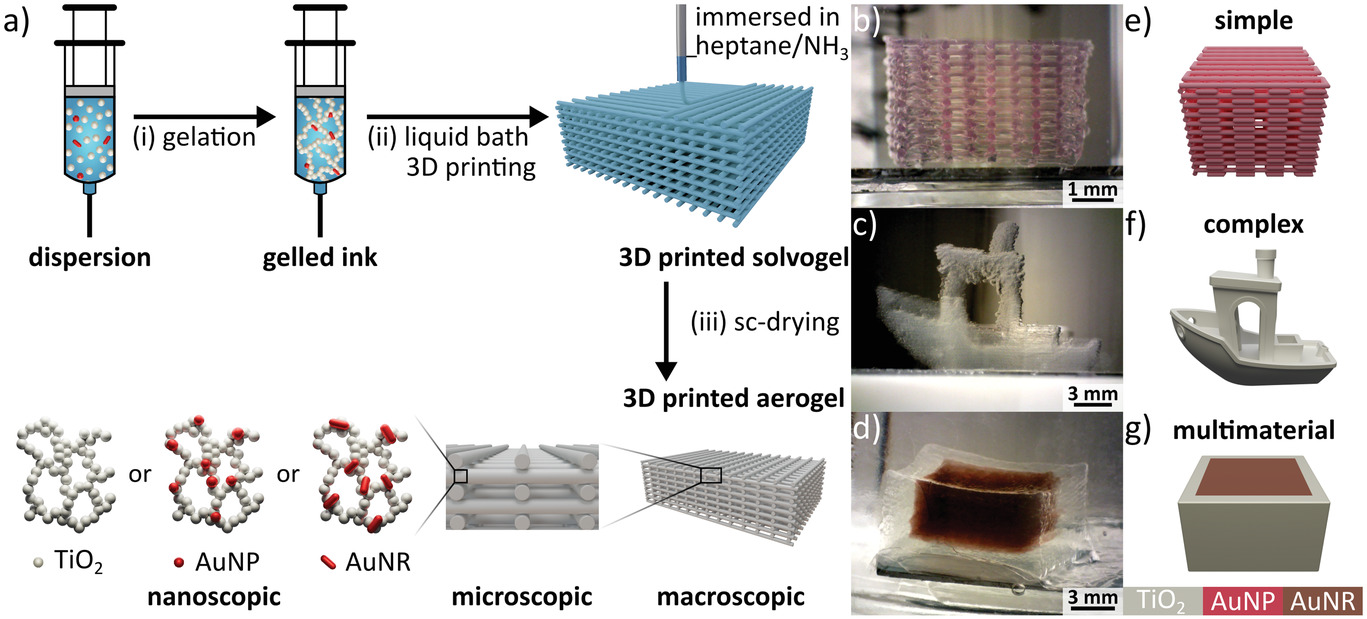
Transforming direct ink writing3D printingTechnology
Aerogels are porous solids that retain the properties of individual nanomaterials on a macroscopic scale. Although nanomaterials of various sizes, shapes, compositions, and surface chemistries can be fabricated, the high-volume fabrication of devices based on macroscopic nanomaterials remains a challenge.
One of the major difficulties in nanomaterial processing is maintaining nanoscale properties across multiple length scales.Gel casting is a method for processing nanomaterials into aerogels, but available
mold
The limited range of shapes and the limited shape tunability of aerogels fabricated in this way hinder the fabrication of complex microstructures.
Researchers decide to write based on extrusion-based direct ink3D printing technologythe technique is derived from
ceramics
Processing developed, materials and equipment can be manufactured from prefabricated pellets. However, ceramics and nanoparticle-based aerogels have different properties due to differences in particle size and porosity.
Therefore, researchers need to formulate additive-free 3D printing inks that are compatible with the direct ink writing process, similar to traditional cast aerogels, in order to obtain nanomaterial properties in 3D printed aerogels.
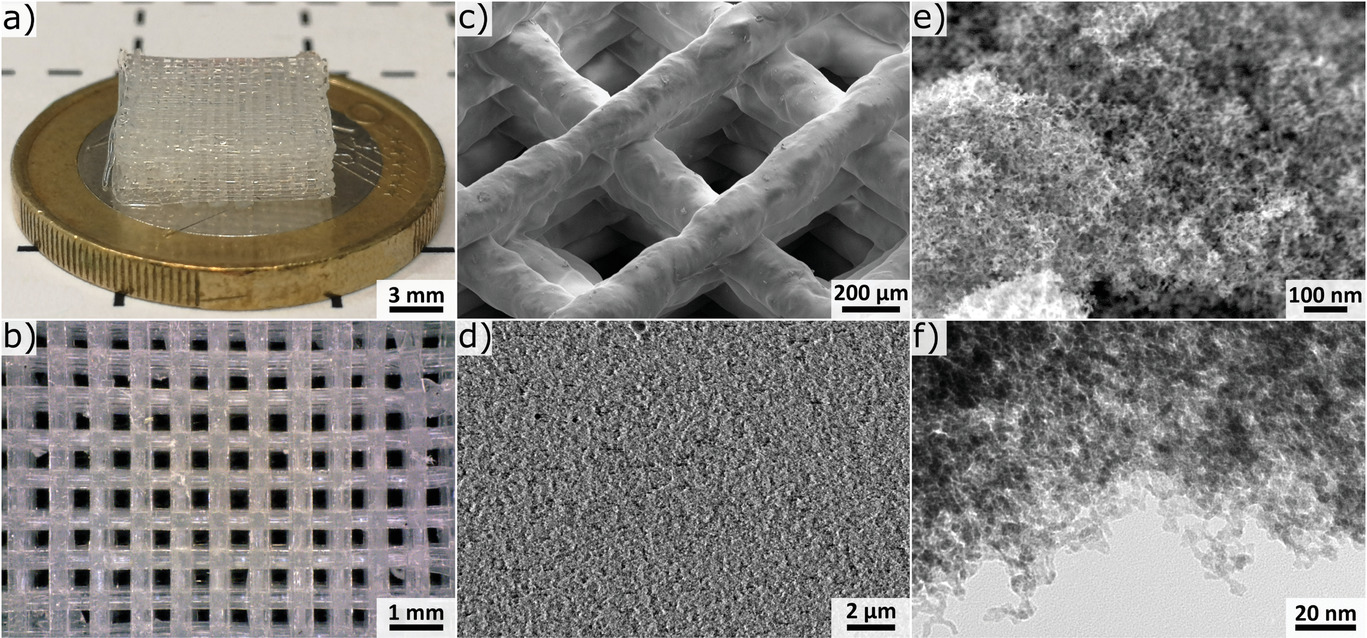
3D printing nanoparticle-based aerogels
Researchers have developed a DIW 3D printing process capable of printing TIO2 aerogels. Instead of using rheological additives to ensure printability (which can be detrimental to the nanomaterial’s properties), the printing process takes place in an alkaline liquid bath. This allowed the researchers to preserve the nanoscale properties of the ink, while also creating macroscopic translucent aerogel geometries.
The ink is first formed from a nanoparticle gel, then 3D printed in a liquid bath, followed by supercritical drying
post-processing
. The researchers found that inks with a particle concentration of 4 percent were best for 3D printing. Using Hyrel 3D’s Engine HR 3D printer, the 3D printing process takes place in a liquid bath to overcome gel damage caused by evaporation when printing aerogels in air.
Furthermore, the researchers found that they could easily handle multicomponent inks by mixing TIO2 with other nanoparticles, such as gold nanoparticles (AuNPs) or gold nanorods (AuNRs), before the gelation process.
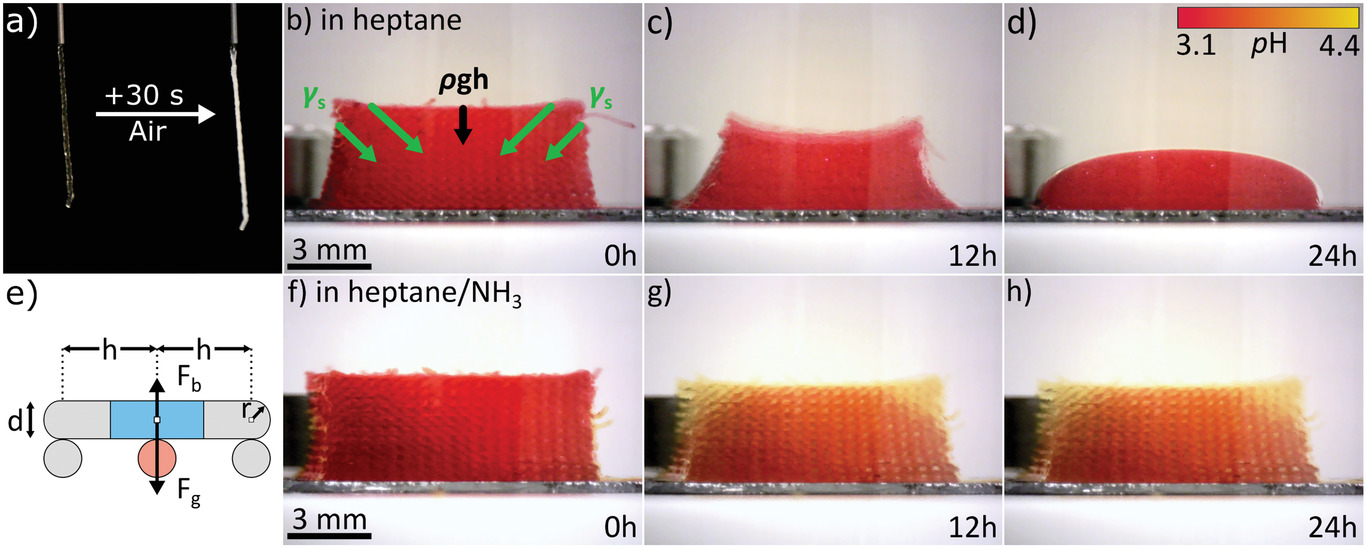
△ The experimental obstacle of TiO 2 nanoparticles-based aerogel DIW. a) Time series of optical micrographs of the to-be-treated TiO gel filaments extruded in air through a nozzle with an inner diameter of 410 μm. Time series of optical micrographs of microgrids 0, 12 and 24 hours after printing in bd) heptane and fh) heptane filled with NH 3 , respectively. e) Schematic diagram of the microgrid printed using nozzles with diameter d = 2r and filament center-to-center distance h. Although (a) all inks were equipped with pH indicators to account for pH-induced TiO condensation gelation. The microgrids in (b,f) were printed with a 250 μm nozzle and consisted of 23 layers, where each layer was an array of parallel filaments with a center-to-center distance h of 500 μm.
The research team printed geometries with high shape fidelity and precision, including void-free cubes, 3D meshes, boats with large overhangs, and other multi-material geometries. The 3D-printed aerogel contains a randomly organized network of interconnected mesopores with pore sizes in the 20 nm range and has the typical relative surface area and low density of traditional cast metal oxide aerogels.
The researchers also successfully combined the superior thermal insulation capabilities of metal oxide aerogels with the photothermal properties of plasmonic gold nanorods. Their DIW 3D printing process not only defines the dimensions of the printed material, but also the composition and photothermal properties at any desired point.
The most important breakthrough, however, was being able to engineer the microstructure of the photothermal aerogels they fabricated to provide better light penetration and more uniform heating. According to the team, this could enable a new generation of solar thermal devices for solar steam generation or thermochemical heat storage.
To achieve this, the team used two printheads loaded with different nanomaterials. Titanium dioxide ink absorbs UV radiation and appears translucent, but when loaded with gold nanorods, it exhibits strong extinction in the visible and near-infrared (NIR) range due to plasmonic excitation. The researchers exploited the free-form capabilities of the DIW technique to locally define the photothermal properties of aerogels and improve their heat production and light distribution properties.
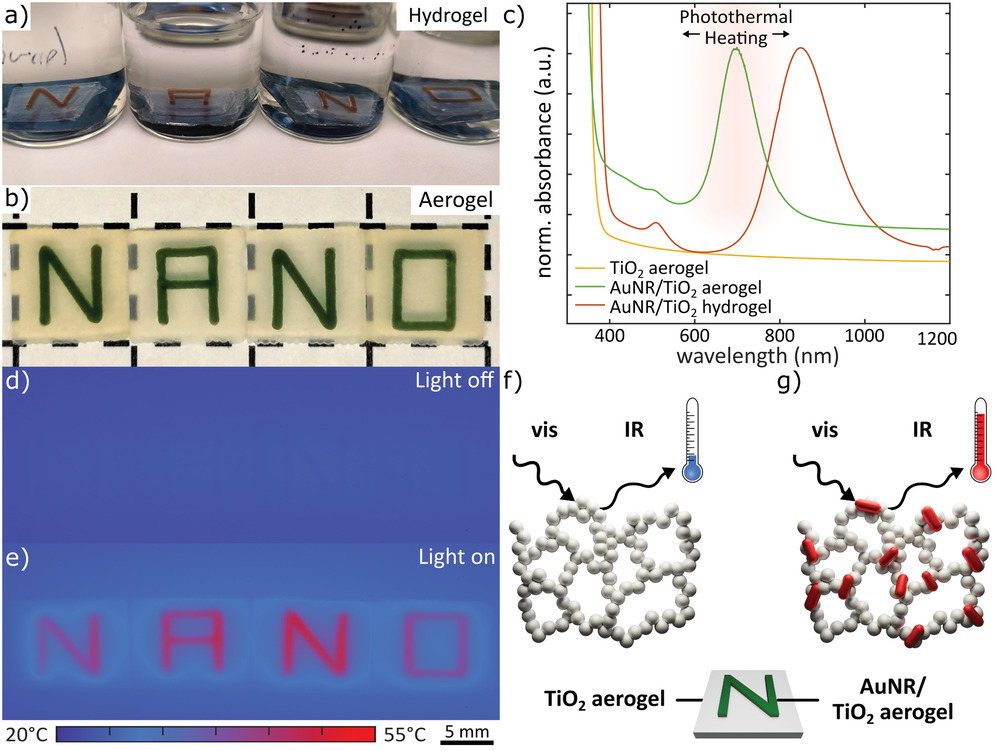
△ Multi-material printing of pure TiO2 and AuNR/TiO2 mixed ink. The AuNR-loaded ink appeared a) reddish in the form of a hydrogel and b) green in the form of an aerogel. c) The UV/Vis absorption spectrum shows that the color change is caused by the blue-shift of the longitudinal plasmon resonance peak, while the dielectric environment is changed from liquid to air by supercritical drying. d,e) Thermal infrared camera images of the structured aerogel when illuminated with the 300 W Xe light source turned off and on, respectively. f,g) Schematic illustration of photothermal heating of TiO and AuNR/TiO aerogels under visible light irradiation. Pure TiO2 aerogels remain low temperature, while AuNR-loaded aerogels heat up due to the strong light absorption of plasmonic AuNRs.
Besides TiO2, the method can also be applied to SiO2, Al2O3 or ZrO2 nanoparticle-based aerogels commonly used in photothermal devices. In the past, photothermal heating of plasmonic nanoparticles has been used in prototype devices for clean water regeneration, energy generation, and photothermal catalysis, but has until now been limited to thin films due to the inability to structure nanoscale properties at the 3D macroscale.
By enabling more uniform heat generation in macroscopic objects, the researchers believe their DIW 3D printing technique offers a completely new approach to fabricating large-scale 3D structured photothermal devices.
For more information on the research, see the paper titled “Additive-free, gelled nanoinks as a 3D printing toolbox for hierarchically structured bulk aerogels,” published in the journal Advanced Functional Materials. This article was co-authored by M. Rebber, M. Trommler, I. Lokteva, S. Ehteram, A. Schropp, S. Konig, M. Froba and D. Koziej.
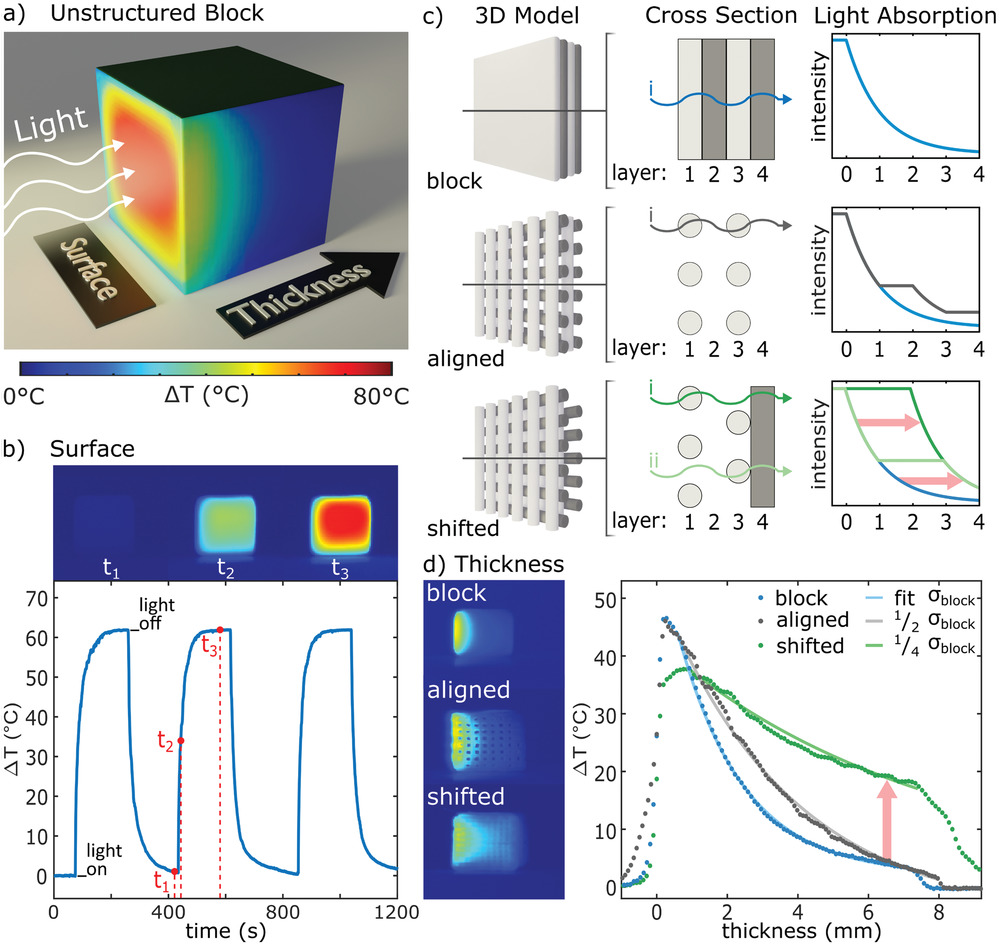
△ Effect of microstructure on temperature and light distribution of 3D printed AuNR/TiO aerogels. a) Schematic diagram of a typical photothermal measurement. The sample is illuminated from one side, while an infrared camera records the temperature of the front or one of the sides. Exemplary temperature data for bulk geometry is shown as a superposition of cubic unstructured samples. b) Temperature-time trajectory of body surface temperature under repeated illumination. The insets show the IR camera images at t1, t2, t3 as shown in the time trace plots. c) Schematic representation of light penetration through three microstructures (unstructured block, aligned and displaced). The 3D model from left to right shows the cross-section and expected light absorption of each geometry. Adjacent layers of geometry are colored for clarity. d) Thickness dependence of the measured temperature distributions for the three microstructures. The bulk temperature distribution is fitted with an exponential function to extract the bulk extinction coefficient σ block. The temperature distributions for the aligned and shifted geometries follow an exponential trend, but with 1/2 or 1/4 of the volume decay constant σblock, respectively.
Paper link:
https://onlinelibrary.wiley.com/doi/10.1002/adfm.202112914
(responsible editor: admin)


0 Comments for “University of Hamburg: Direct ink writing technology 3D prints TiO2 nanoparticle aerogels”